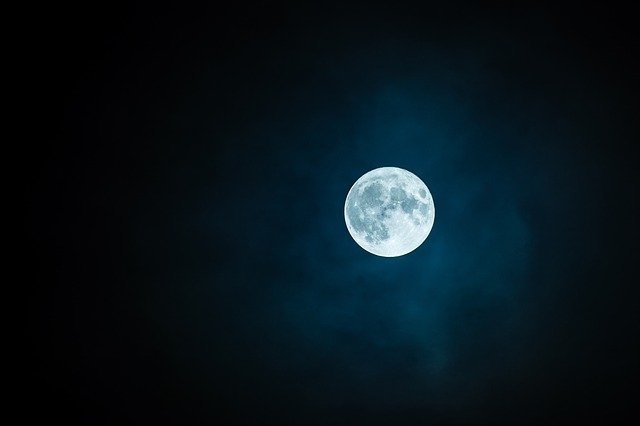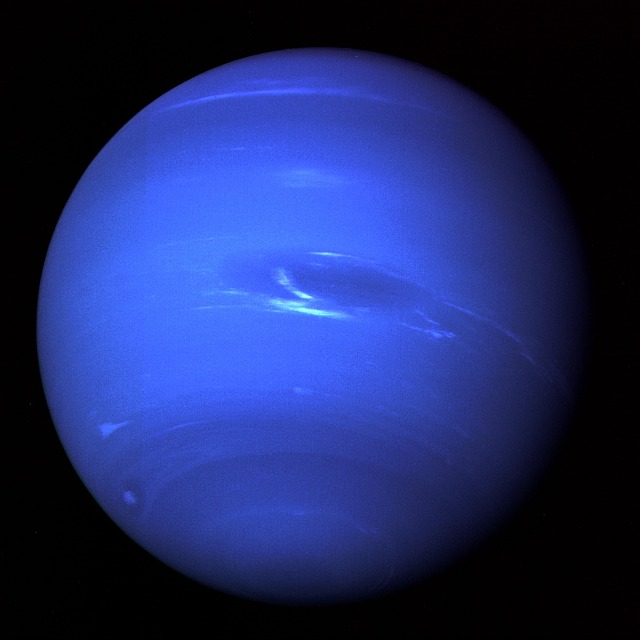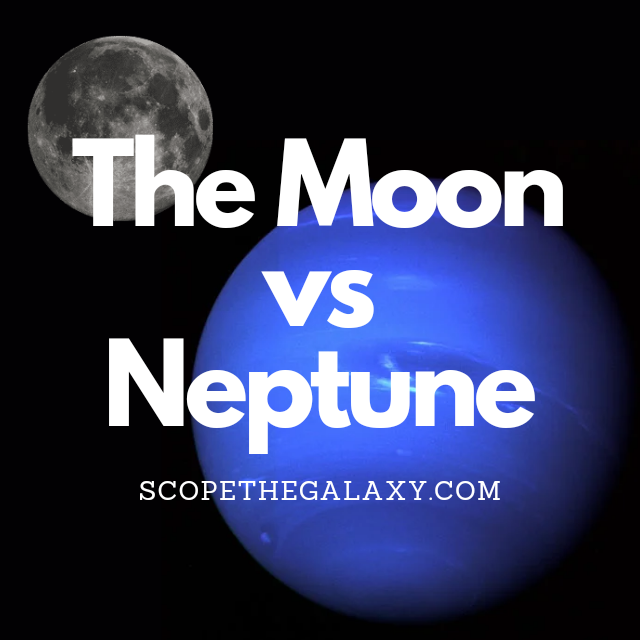*This post may contain affiliate links. This means we may make a commission if you purchase an item using one of our links*
The main differences between Neptune and the Moon is that the Moon is a rocky terrestrial natural satellite that orbits Earth whilst Neptune is and ice giant with 14 natural satellites orbiting it, the 8th farthest planet from the Sun and wind speeds of 2,000 km/h, which means it has the fastest wind speeds amongst all the planets and natural satellites in our solar system.
There are numerous other differences between the two so continue reading if you want a more thorough breakdown of the similarities and differences between the Moon and Neptune.
What Is The Moon?
Table of Contents

The moon is the gray celestial being that orbits our Earth. It is also tidally locked to Earth meaning that we only see one side of it at any time in our sky.
It takes the moon roughly 27 days to complete an orbit around Earth, which it does in an elliptical pattern. The Moon’s axial tilt is very straight at 1.5 degrees. As a result of the tidally locked status along with the effects that Earth has on its general rotational patterns, it takes the Moon roughly 29.5 days to complete a day.
In regards to its temperature, it fluctuates where it can be really hot at 127 degrees Celsius when the Sun is shining on it and to -173 degrees in areas where the Sun does not strike it. It’s core on the other hand is far hotter ranging between 1,327 to 1,427 degrees Celsius.
This is as a result of the lunar entity’s extremely thin to practically non-existent atmosphere, which not only results in these massive temperature shifts but, is also the reason why it has over 100,000 craters on its surface.
Speaking of the Moon’s surface, the entity is mostly made of rocks, iron, magnesium just like most of the other moons and terrestrial based planets in our solar system.
It is among the bigger moons in our solar system with a diameter of 3,474.8km and a mass of 7.35 × 10^22 kg, which actually places it fifth amongst all moons in our solar system and would also make it bigger than the dwarf planet Pluto.
Despite all the advancements in technology, the last time a manned mission was made to the Moon was on the Apollo 17 way back in December 1972 and no further missions have been done since, possibly as result of the political agendas behind the numerous countries vying for opportunities that we don’t know of.
What Is The Planet Neptune?

Neptune is the 8th farthest planet from the Sun and ranks among the bigger planets in our solar system. As the 8th farthest planet from the Sun, it does take Neptune a very long time to complete 1 orbital cycle around the Sun.
This takes 165 years to complete which is far longer than the 16 hours needed to complete 1 full day/full spin around the axis.
In regards to its composition, Neptune is mostly made up of a thick swath of water closer to the center, methane, ammonia, hydrogen and helium molded around its Earth sized core.
As a result of the excess amount of methane and the inclusion of another undiscovered element within the atmosphere, Neptune’s color is a far deeper blue than the likes of Uranus, which also has a methane based atmosphere.
The planet is 49,244km in diameter, making it roughly 4 times Earth’s diameter, and would allow around 57 Earth sized planets to fit inside it. This also makes Neptune the 4th largest planet in our solar system.
Neptune is very cold, which is mostly down to its distance from the Sun, where its atmospheric temperature sits between -220 to -230 degrees Celsius. Its core is far hotter coming in at 5,100 degrees Celsius and is the very likely cause for the liquid water present within the planet.
Subsequently, the erratic temperature and gaseous composition of Neptune, is what constitute towards its turbulent behavior.
In fact Neptune has the fastest winds in our solar system, producing some that eclipse speeds of 2,000km per hour. The fastest winds on Earth would only be a fifth of these speeds at most.
At this moment in time we have discovered 14 moons orbiting Neptune and have also observed 5 thinner rings surrounding the ice giant.
Similarities Between The Moon And Neptune
Neptune and the Moon don’t have too many similarities but some elements are still shared, which in this case includes the below:
- Both are a spherical shape.
- Both have a hotter core.
- Both also orbit another entity.
Differences Between The Moon And Neptune
In regards to the differences between these two, they include the following:
- Neptune is an ice giant planet whilst the Moon is terrestrial natural satellite.
- The Moon orbits Earth in an elliptical pattern whilst Neptune orbits the Sun in a circular pattern.
- Neptune has 14 other moon like entities orbiting it whereas the Moon has none.
- Neptune has 6 known rings orbiting it whilst the Moon has none.
- The Moon is far smaller than Neptune with a diameter of 3474.8km whereas Neptune’s diameter is 49,244km.
- The Moon is tidally locked to Earth whereas Neptune is not tidally locked to any of its moons.
- Neptune is the 8th farthest planet from the Sun, meaning it takes it 165 years to complete a full orbital cycle around the Sun whils the Moon is joint 3rd with Earth taking it roughly 365 days to complete an orbit around the Sun.
- A day on Neptune takes 16 hours to complete whereas a Moon day is 29.5 days.
- Neptune has an axial tilt of 28 degrees which is far more than the 1.5 degree axial tilt of the Moon.
- Neptune is significantly heavier with a mass of 1.024 × 10^26 kg as opposed to the Moon’s which is far less at 7.35 × 10^22 kg,
- Due to its distance from the Sun, Neptune is the colder of the two entities with an average temperature ranging between -220 to -230 degrees Celsius whereas the Moon’s ranges from 127 to -173 degrees Celsius.
- The Moon’s core temperature is between is 1,327 – 1,427 degrees Celsius whereas Neptune’s temperature is 5,100 degrees Celsius.
- Neptune is a deep blue color whilst the Moon is gray.
- Due to its size, Neptune has far more influences over its surroundings therefore, its magnetic filed strength and gravitational field strength is far more than the Moon’s.
- As a result of the extremely thin atmosphere on the Moon, there is practically no wind on it whereas Neptune’s thicker atmosphere causes it to have the fastest wind spins amongst all the planets in the solar system at 2,000 km/h.
Summary
Neptune is a gas based ice giant whilst the Moon is terrestrial natural satellite that orbits Earth. They differ in numerous ways whether it be their atmosphere and weather, their overall size, temperature and how they affect their surroundings.
As a result, despite being located in the same solar system, our Moon and Neptune function very differently form one another


